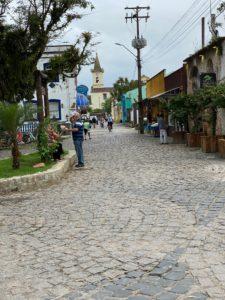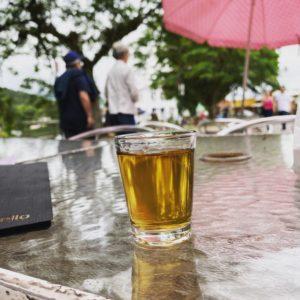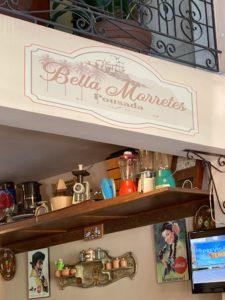 Morning in Morretes. I left the pousada because I woke early. Breakfast wouldn't be served until eight. Clouds covered the not-so-distant-mountains, but the city was sunny. I walked along the quiet main road. People passed me on their way to work.
Morning in Morretes. I left the pousada because I woke early. Breakfast wouldn't be served until eight. Clouds covered the not-so-distant-mountains, but the city was sunny. I walked along the quiet main road. People passed me on their way to work.
Schoolchildren carried backpacks, walking in groups, excited for the school day. I crossed over the river on a slight bridge that carried the occasional car. Descending the opposite bank, I walked the cobblestone path, which was without another soul.
I snapped a few pictures of the river, a small colorful bird, an orange flower. The city was fresh, it seemed. I followed the path as it took me past a special education school and several closed restaurants, until a bridge led me back across the river.
Men sat in a park talking, but didn't glance in my direction. I walked past the closed shops and restaurants in the historical district and found myself a spot to sit by the river.
A few other people, who didn't look much like tourists, took places along the river, as well. We sat there, all of us, enjoying the beginning of the day.
Around eight, I returned to the pousada, with a hunger in my belly. There was fruit, pão de queijo, sandwich makings, hot dogs, and various and assorted cakes. The coffee was fairly good, as was the fresh squeezed juice.
I'd determined, that morning, sitting by the river, that I'd go to the nearest distillery that day, which happened to be Porto Morretes. The directions seemed straightforward, and when I began, it appeared that I was only a few kilometers away.
What I didn't account for was the pure horror of the road itself. The farther I went, the worse it became, moving from hardly agreeable cobblestone to uncut rocks buried in the dirt. While cars sped by me, a clear lack of care exhibited for their suspensions, I drove under 10 kilometers per hour.
After about 15 minutes, during which time I drove no more than two kilometers, I arrived at my destination. In front of me was a closed gate, with a sign declaring that all visitors needed to make an appointment.
Not having any bars, I knew that I'd have to make a call later. There were two other distilleries relatively nearby, however, and I wasn't going to let my morning and afternoon go to waste.
I made my way slowly back into town, my tires apparently unperforated, and headed to dom Henrique, which was about ten kilometers from town.
The sky began to close and rain began on the drive. I pulled into an empty parking lot, a number of rustic buildings surrounding me. A young man came from the main office. I told him a bit about what I was doing on this excursion and he spent the next twenty minutes telling me about his business.

It was clear from my conversation with this young man that there was no relationship with other distilleries in the area. If anything, it sounded as though there was a bit of jealousy. The other two distilleries I would later go to are better known than dom Henrique, and therefore, it's likely that more tourists go visit them.
We walked around the expansive grounds, underneath the steel sky. It was a picturesque location, undeniably. We then returned to the store. I bought a bottle of the blend and thanked the young man for his time. I headed out, on my way to see the second of the distilleries in the region.
Ouro Morretes was much closer to town, and though it was nearing lunch time, I hoped that they would still be open. I was met by Guillherme, who was more than happy to have someone visit. It was the middle of the week and the on-site pousada also had no visitors.
Upon entering, one gets a sense of the vast history of cachaça in Morretes. It had been such a well-known destination that even the Emperor of Brazil, way back in the 19th Century, had travelled to the area and sampled its wares. This was a point of pride for Guillherme.
In the 1970s, there were dozens of distilleries. But, due to some kind of federal government restrictions, every single one of them went out of business. The only ones that exist today are due to an effort in the 2000s to reclaim the cachaça heritage.
Guillherme gave me an exceptional tour of the distillery, perhaps the best one I had during my trip. Ouro Morretes produces only 8,000 liters of cachaça per year. Part of the reason for this is that the town restricts the growth of sugarcane, a fact of which I hadn't been aware. The site had previously been a pencil factory, but the purchaser had decided to create a distillery and a pousada.
After the tour over the expansive grounds, I got to tasting this solid product.

By the time I left the restaurant, the rain had stopped. I walked along the main strip in the old town area. There was a cachaça store, with one lone employee. It had few cachaças, but I bought a bottle anyway. I took a stroll, leaving the downtown area for the commercial district where proprietors sold everything from phone cases to p omonha.
I returned to the downtown area. A beer garden, which I'd noticed the previous day, set up next to my pousada welcomed me with suds and various other culinary delights.
When I was done, I returned to the restaurant from the previous day. There I met a waiter who had lived in Chicago for ten years and ran an eco-tourism company, which presumably wasn't doing that well. I thought about whether it would be worthwhile to take a tour. I got his information and ended the day with another nice meal, which included a chicken sandwich and a green salad.
The sun went down and I was ready for bed. I'd already seen two thirds of the distilleries in Morretes, but there was still more to see.

